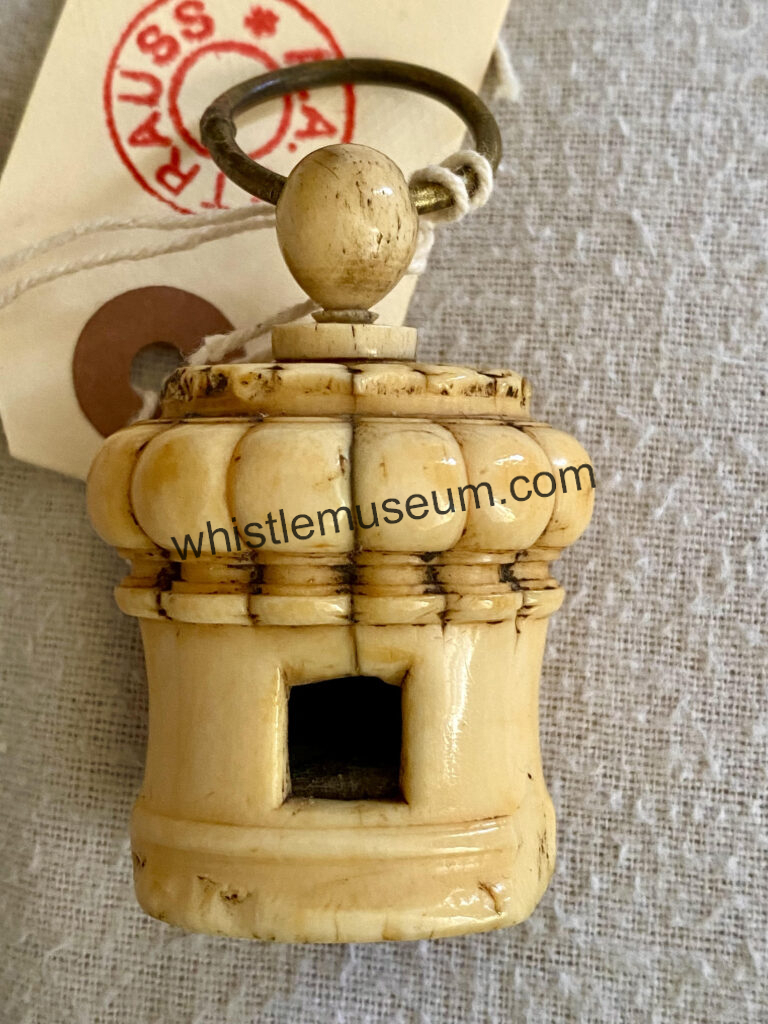
size app. 2″ by 1.5″
Antique whistle review
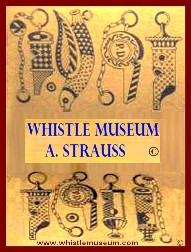
Two important American whistles long searched for by whistle collectors
were found April 2019.
Alexander P Hatch Patents were thought as none existing, since none were seen and the patents applied for stated no model examples.
As to rarity we know of another Plural whistle I discovered with a long time U.S.A collector in 2016, The Police one is the only example I know of.
I imagine there are more to be discovered and there is a good chance that the more fancy variation with few combined whistles as seen on the same patent of the plural whistle is somewhere out there… (so it is with the British Plural one that I posted the patent for last year, no actual example ever seen – it is from the same period)
keep your eyes open it is a treasure probably worth well over a 1000, hopefully with more exposure to the ones that just surfaced more will show up in the future.
It is a pity that there is no information about this inventor who was a citizen of Bridgeport Connecticut at the time, I am sure an extensive research can reveal much more as to his life, Albeit the fact that his whistle patents are among the most cited by whistle inventors, dozens of newly patented whistles since then quote his patents, including 21st century ones.
 Alexander P. Hatch American Whistle patents App. for 1899 & 1901
Alexander P. Hatch American Whistle patents App. for 1899 & 1901
Both are made of Nickel Plated Brass.
I highly recommend reading carefully the patents description & drawings in the next links.
The one on left side is know as the plural whistle and you may see the patent drawings and description HERE at google patent storage
It was found with the original chain in an old bicycle store, in mint condition.
The whistle on the right a tube whistle with unique design and partition is stamped
POLICE DEPARTMENT and has patent date as well see google patents HERE
All rights reseved to A. Strauss Whistle museum
we are glad to help with any questions regarding whistles,
please attach photos to questions, Email: info@avnerstrauss.com
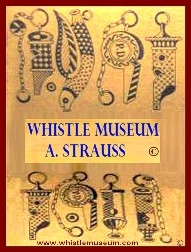
A Round Pea Whistle, dating c. 18th century to early 19th century,
An outstanding example of a design using various geometrical elements
forming a uniquely sculpted design.
From the country were Stradivarius made his violins in the 17th & 18th Cent.
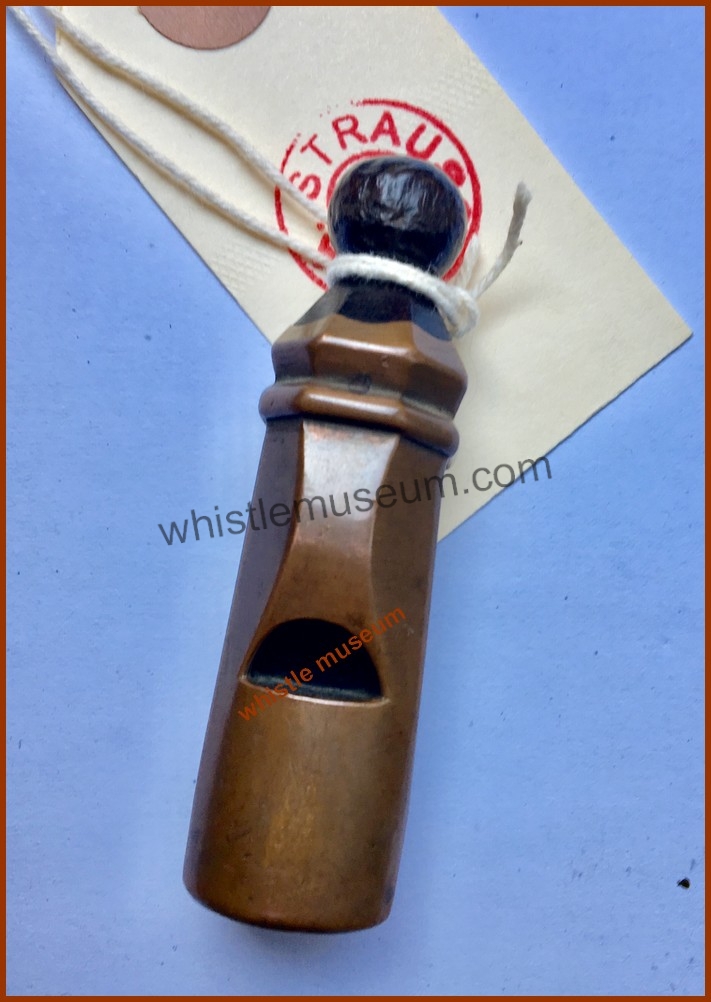
Materials: Gun Metal (a type of bronze – an alloy of copper, tin, and zinc )
& painted extra hard wood.
L: 69 mm Continue reading A Military Round Pea Whistle 18th to Early 19th Century Design Masterpiece. A. Strauss
These whistles were registered by ACME WHISTLES,
J. Hudson & Co. Birmingham in 1911 They are similar to button whistles in having an emblem embossed on cap, and are all made of nickel plated Brass.
The Rose
Reg. design # 576579 Model # 618
The Symbols (From Wikipedia)
A shamrock is a young sprig, used as a symbol of Ireland. Saint Patrick, Ireland’s patron saint, is said to have used it as a metaphor for the Christian Holy Trinity.
The thistle has been the national emblem of Scotland since the reign of Alexander III (1249–1286) and was used on silver coins issued by James III in 1470. It is the symbol of the Order of the Thistle, a high chivalric order of Scotland.
The white of York and the red of Lancaster are joined together to make The Tudor rose, marking the union of the two houses and the beginning of a Tudor reign. The Tudor rose was used as a symbol of peace and today it is used as the symbol of England, just as Scotland uses a thistle,
Wales a leek and Ireland a shamrock.
These Registered designs were unique to Acme whistles (see exception* ) and were popular for at least 25 years ahead in different additions and variations. Without going into all the details I will mention that there are dozens of variations, and in GENERAL they vary at 3 main features :
THE TOPS 4 TYPES
1) Bubble top
2) Humpback Tops
3) Humpback with Groove (Implied to whistle by wiring technique)
4) Flying V top (See photos below)
All the three show with these variation:
Early with reg. design number embossed on cap
Later no number NO number embossed to cap
Number embossed to cap at one side
The Tudor Rose Early with 1912 Patent stamp on cap
with or without number (Only on Tudor Rose,*)
The Acme Registered,
The Acme Registered with arched emblem name ( Rose, Shamrock, Thistle)
The Acme Registered and England above the Tooth grip.
No Stamp at all
There may be one having both the emblem name and England, I had not seen one yet.
Dating the variations between 1911 to C. late 1930s I believe, is not an easy task,
but one can rely on the various Tops & Stamps.
The price of whistles in these
whistles varies a lot and the earlier bubble tops first edition is over 100 USD if to judge by the last ones observed on eBay.
NOTE that a whistle can find a Whistle with a BUBBLE TOP and any of the Caps & Stamp variations which more than triples the variations.
Here is the Tudor rose on left (One or two known**)
and on the center and right BOTH ARE Shamrock with two different stamp variations.
So a full set of three Bubble tops
1) Numbered on side / the name of the emblem at front /
2) Another set : Bubble tops / no number on side / and the name of emblem on front / ETC.
There are at least 5 variations of a FULL Trio Bubble tops set
A complete early edition would have 15 whistles 5 sets of three bubble tops
(as in Postage stamps )/ and that does not include the tudor roses,
and and there are still 3 other style tops (None bubble series)
The Tudor Rose Close
Here one may see number P-608282 -12
1912 Patent 608282 on cap and England above tooth grip Observed only on the Tudor rose



Closeup on a Thistle Bubble top and Number on side cap
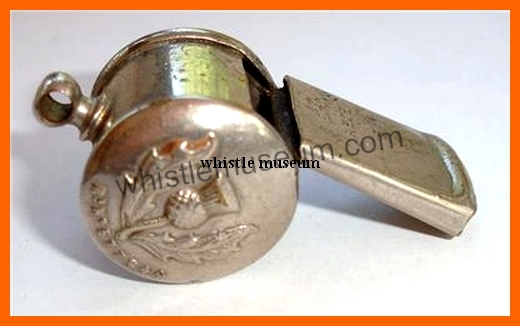
Another previously unknown earlier variation of a Bubble Top Shamrock
surfaced October 21. Found not far from Birmingham.
Probably an earlier pre Registered design experimental model.
Here on right hand is the Beak front view. for comparison.
 A close inspection of construction reveals the DISTINCT Tooth grip location right at the opening of the beak upper lip, as in the 131 Barr St. I had the luck to discover in 2006, a previously unknown one, which was a major find in research & study of Hudson’s escargots timeline. since then few more 131 Barr St. variations were found.
A close inspection of construction reveals the DISTINCT Tooth grip location right at the opening of the beak upper lip, as in the 131 Barr St. I had the luck to discover in 2006, a previously unknown one, which was a major find in research & study of Hudson’s escargots timeline. since then few more 131 Barr St. variations were found.
_
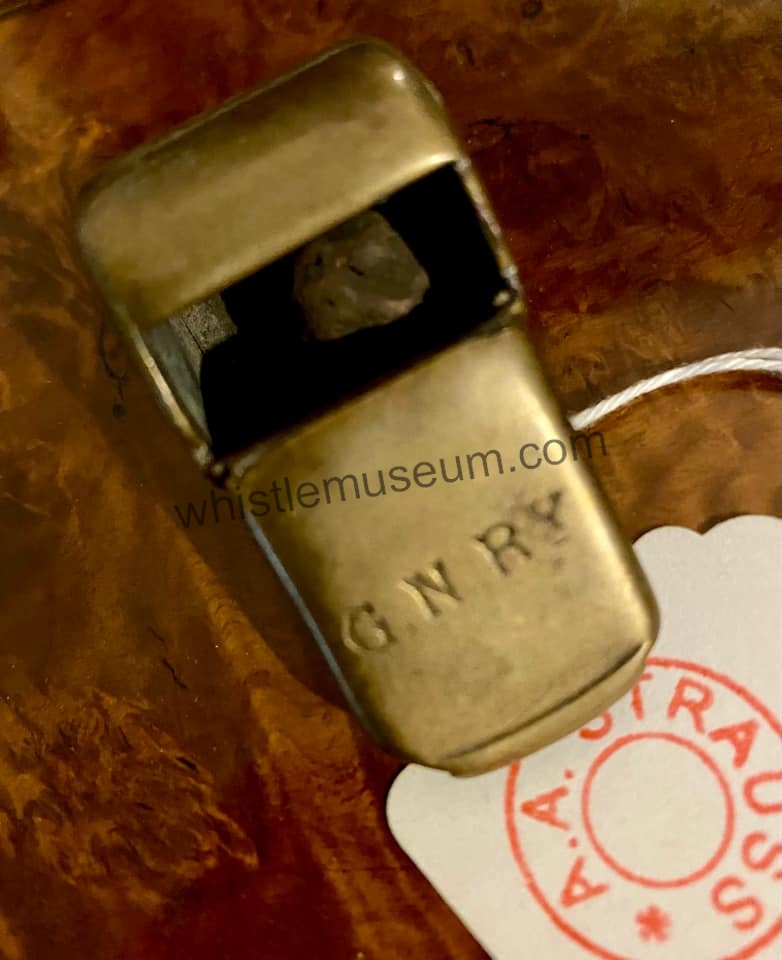 The bubble top at the top one is of older type. (Does remind of Black & Co.)
The bubble top at the top one is of older type. (Does remind of Black & Co.)
With a very short ‘neck’ under bubble and wide base.

So we can conclude that this is an earlier variation, Pre 1911.
Multi view of a ‘named’ stamped Shamrock on beak.
Flying V Top J. Hudson & Co. Patent # 214519 / 1924 Made 1924 onward
Reg. Numbered design embossed on side cap is an earlier 1920s version  Example of a later edition 1930s with Shamrock emblem,
Example of a later edition 1930s with Shamrock emblem,
no emblem name on stamp, no number on cap and
HUMPBACK Top(Hamp top).

Full set of POST 1924 series but still NOTE STAMP VARIATIONS ON FRONT
reflecting period variations 1920s 1930s
While writing I encountered the next whistle which was made earlier has a button like domed sides and has the same feature as the 1911 ones, the Feature of “Folded Beak” construction with a seam which can be seen in the middle of the underside.
It was used by Acme since 1894, (Dixon used it as well at the same time including domed sides, one example found in 2018)
The whistle came in 3 sizes see catalogue excerpt below, here is the smaller one model number 61 and 1/2
It has a brass salesman tag with model number, and it is an earlier one since later they used Aluminum tags.
This type was made by Hudson & Co. Acme Whistles Ltd. up to the 1970s.

Catalogue excerpt showing the 3 domed sides lite construction snail whistles
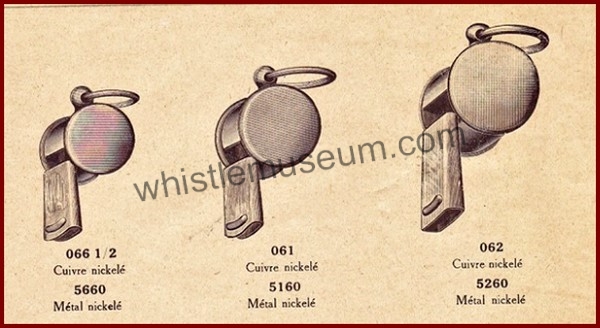 These models were later developed and in the 1930s had 4 sizes
These models were later developed and in the 1930s had 4 sizes
(061 & 1/2 size added ) and another ACME LOGO embossed emblem of THE ACME logo replace the plain domed sides.
Very nice whistles and again many variations, see catalogue for 4 sizes starting
with the same 66 & 1/2 Model as the smaller but now with The Acme Logo side.
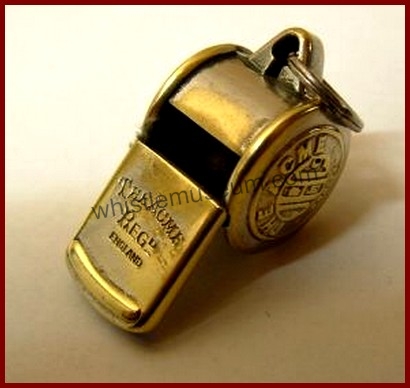
Made in 4 Sizes 1930 Catalogue

There are few more themes of embossed sides button style snail whistles by ACME WHISTLES LTD. ( J. Hudson & Co. ) of which the dog head is the most famous but I will discuss this at some other time.

מוזיאון משרוקיות
Early ‘Bobbie Whistle’, Whale-Bone Pea Whistle Pre Metropolitan Police Constable Whistle from Hill’s Family.
1821 Early ‘Peeler’, ‘Bobbie Whistle’,Whale-Bone Pea Whistle Pre Metropolitan Police Constable Whistle from Hill’s Family. The next email and photos I quote word for word with some private lines omitted, is from Mr. John Hill Noted for his Great Articles about Historic Places and Cultures among others.
I received it with answers to my questions, I chose to put Some technical and Family history in Bold letters.
Dear Avner
What a pleasant surprise it was to receive your friendly and interesting email. And what a treat it was to discover your fabulous website on whistles – it is absolutely wonderful – congratulations!
My father said it belonged to his great-great-grandfather who was a “Hill” who lived in London and was one of the early “Peelers” (also called “Bobbies” – after Robert or “Bobbie” Peel) or the specialist police set up on the suggestion of Sir Robert Peel in 1814 in Ireland and, in 1829, 1000 men were formed into the “Metropolitan Police Force” who were regularly referred to as “Peelers”. It apparently belonged to him and he carried it while at work. I was lucky enough to inherit it from my father.
We don’t know much about this distant ancestor as the family history seems to have been broken when my grandfather, Alfred Hodson Hill (1887-1977), moved c. 1910 to Montreal, Canada. Before that, his father (who was a silversmith and son of the “Peeler” who owned the whistle) and family moved to Sheffield from London at some unknown date in the 19th century.
That is about as far as the family stories go.
How lovely to hear back from you! I only wish my father was still alive – he would have been so excited to find someone so interested in his family heirloom.
It truly is a unique whistle – i have been very fond of it since childhood and always impressed with the fact that ti is undoubtedly unique.

The whistle is, as you know, carved in the shape of a whale in
(presumably) whale-bone – but maybe from sperm-whale teeth or walrus ivory – I wouldn’t know how to tell the difference – can you help with this? Also, would it be useful for me to gently rub it with mineral oil – or do you have another suggestion – or, should I just leave it alone ?
One blows through the mouth of the whale to make it whistle. It does have a dark brown “pea” (roughly 8 mm. in diameter) inside the whistle, and the hole (where the sound comes out) does not contain a reed or anything other than the original piece of whale bone – with a sharp-edged hole cut into it.
It is just about exactly 8 cm long, 3cm wide at the widest point, 2 cm high
at its highest point (on the top of the whale’s head),
and about 1.5 cm wide at the narrowest place.
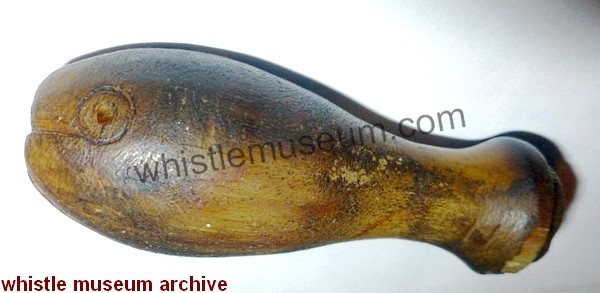
It still has a good-sounding loud, piercing whistle –
I still use it occasionally to call guests from a little cabin we have about 80 metres from our home.
Cheers
John
If I may add I believe the maker was a very fine skilled craftsman who hopefully made other whistles as well. It is also notable that it is a PEA WHISTLE.
Whistle Museum all rights reserved.
Contact: info@avnerstrauss.com
ROUND & ROUND PEA WHISTLES
This part starts with metal whistles (one wooden) excluding Britannia metal made whistles which are to be uploaded later, and continues with Ivory,
Horn & Stag horn made whistles. Materials & Identifying features for Dixon whistles would be discussed later. The Part dealing with round whistles terminating with an Animal Head can be viewed here, Part I here,The begining of Part II. a., Here.
Dew to the length PART I of the article was divided into 7 parts, all posted.
Dixon’s whistle’s timeline divided roughly to three periods over the 19th century;
Early – Pre 1835 Dixon, Dixon & Son
Middle – 1835 Dixon & Sons
Later 19th Century c. 1865 – 1900
The earliest whistles Dixon made were round whistles.
These were very sturdy cast or machined from one metal rod with no hole at top, the drilled hole came later, I believe the early ones were made mostly for military use. and later quality was upgraded in terms of materials and designs for the elite, sportsmen, and later for railways.
A very early type: A special knot was used to tie a lanyard to the whistle’s top;
A special knot was used to tie a lanyard to the whistle’s top;
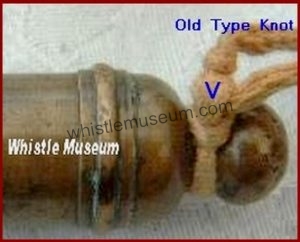 This whistle uses the “Sheffield Fipple” (a term I coined here) which is discussed in details, in a later paragraph here, and the round metal band below mouthpiece which may well be unique to Dixon (to be verified).
This whistle uses the “Sheffield Fipple” (a term I coined here) which is discussed in details, in a later paragraph here, and the round metal band below mouthpiece which may well be unique to Dixon (to be verified).
The next photo shows another very early Dixon on the left with the same features but a different top design, mushroom like.
A very early type beside the ‘next generation’
 Continue reading James Dixon & Sons Part I. a. Round Whistles. A.Strauss
Continue reading James Dixon & Sons Part I. a. Round Whistles. A.Strauss
John. M. Westwood * whistle maker b.1856 – d. 1886
His family (James Westwood His Dad) seems to have come from New York with his other brothers, all in the brass foundry business (His brothers in the trade James, Robert, Alexander ) & a relative named Andrews who shows up later as working with him).
John opened his own business in 1872 as Tinsmith and Gas Fitter at 73 Cumberland St. Calton, Glasgow .
 Excerpt from 1973 Directory.
Excerpt from 1973 Directory. Westwood made a whistle which later became the model identified with S. Auld whistles.
Westwood made a whistle which later became the model identified with S. Auld whistles.
Continue reading John Westwood The first Glasgow Whistle Maker & Samuel Auld Whistles Breaking News ! A. Strauss
 Drawing of the Patent, originally designed to be made in large size as steam whistle of brass, or a small tin mouth whistle.
Drawing of the Patent, originally designed to be made in large size as steam whistle of brass, or a small tin mouth whistle.
Continue reading The First Known Patent for an American Escargot, Snail, Referee Type Whistle 1869 USA Patent , Early American whistles (1) A.Strauss
This function has been disabled for Whistle Museum.